
a web page by Don Roberson |
Sooty Fox Sparrow: the unalaschcensis group |
Sooty Fox Sparrows are currently allocated to six subspecies* with the approximate ranges shown by blue circles in this map (from Weckstein et al. 2002). They nest along the coast of Alaska and British Columbia from the inner Aleutian Islands to Vancouver Island. They are famous for the "leap-frog" migration pattern. Those subspecies breeding the farthest north (unalaschcensis, insularis, sinuosa) winter the farthest south, thus "leap frogging" over the wintering ranges of more southern-breeding subspecies. The southernmost subspecies (fuliginosa) winters from within its breeding range to northern California, while those nesting much farther north fly all the way to southern California to spend the winter. * other subspecies have been formally described, most recently chilcatensis from the Chilkat River area of BC/AK, but only the six on the map appear to be widely accepted at the current time. Others, such as meruloides [often found on specimen tags] have been merged into annectens. |
||||||
Here (left) is a summer photo from Homer, Alaska [26 Aug 2009 © Aaron Lang]. It is a bird attending a fledgling at a nest, so we know it is sinuosa because it is within the range of sinuosa, so we can compare this known sinuosa with birds in MTY. The race annectens is said to be "brighter and more ruddy than sinuosa but not as dark as townsendi" to the south. |
||||||
|
||||||
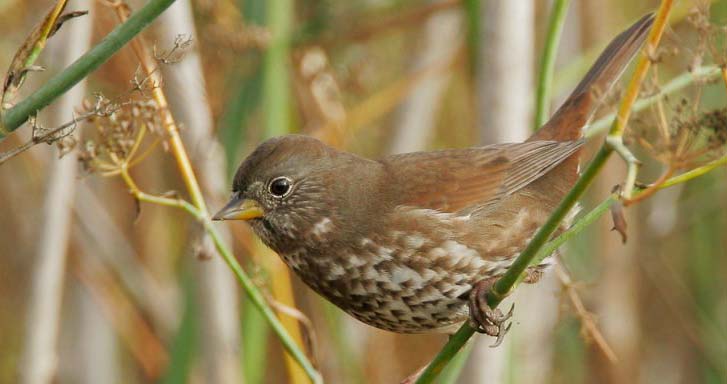 |
||||||
Likewise, the one to the left is quite dark and heavily spotted below [photo 29 Mar 2008 Ed Levin Park, Santa Clara Co. © Glen Tepke]. It has gray in the face and neck to the back is dark brown. The wings and tail are rusty-brown with a reddish cast (like the one above) but those are still so dark they don't contrast sharply with an overall gray-backed, gray-headed bird (as Slate-colored Fox Sparrow should be). My guess is that this bird is townsendi, but it could be assigned anywhere in the 'middle' of the Sooty range: sinuosa to townsendi. |
||||||
On all the Sooty Fox Sparrows shown, note that the lower mandible is always contrastingly yellow to yellow-orange. |
||||||
In short, local observers on the central coast should study their Fox Sparrows, and begin to sort them into manageable groups. Most should fall within the mid-range Sooty Fox Sparrow set, typified by sinuosa and annectens; a few wintering birds will be decidedly darker, consistent with townsendi or fuliginosa; and a few migrants spring or fall can be paler, suggesting unalaschcensis or insularis. Each Sooty Fox Sparrow should have a yellow or yellow-orange lower mandible and, if they call, it will be a rich thik note. |
||||||
I know very little about the northwesternmost races unalaschcensis and insularis, which are supposed to be a paler brown above than sinuosa/annectens. They are simply migrants through our area: a MTY specimen of unalaschcensis is from 10 Mar 1920, a good migration date, although a Dec specimen attributed to insularis suggests that it wintered locally. I don't have any examples of either westernmost race that I'm comfortable with identifying. I don't know about this one (below), photographed 5 Nov 2006 at Alviso, Santa Clara County (© Tom Grey). It does seem very brown but not really dark brown, and the gray in the face is much reduced. The bill is so yellow that it includes everything but the dark culmen. The uppertail coverts are rusty-red, but it seems to me that the wings and tail are less so (although still ruddy in tone). Perhaps this is an actual unalaschcensis? The date is okay for a migrant through the Bay Area. On the other hand, this might just be sinuosa with reduced gray in the face. |
||||||
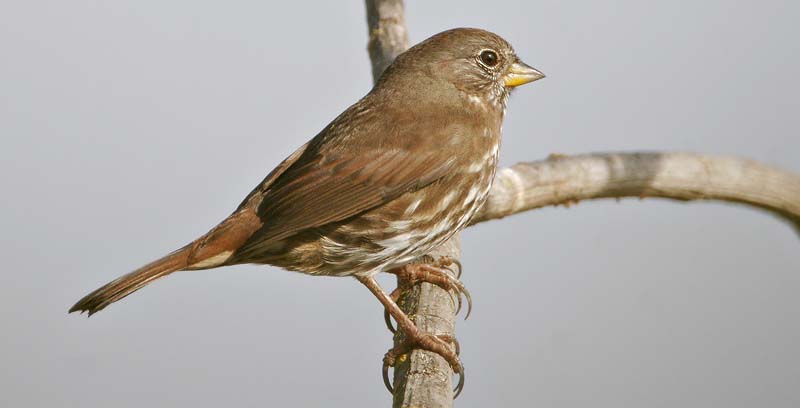 |
||||||
| A significant problem in discussing Fox Sparrows is talking about concepts that are subjective, and in this discussion nothing has been so subjective as to whether the rusty wings/tail of a particular bird contrast with the back/head or not. The bird above is such as example, and so is the one below, photographed 21 Jan 2006 in Oakland. The date is mid-winter so I would assume this must be within the sinuosa/annectens set (but perhaps other races winter in small numbers?). It seems to me that the tone of the brown is not dark enough for townsendi/fuliginosa. If you look closely, the bird does have wings, tail, and uppertail coverts that a richer rusty than the rest of the bird, but not strikingly so. Unitt (2004), who reviewed many specimens, stated that Sooty Fox Sparrows "have the entire upperparts almost uniform, the wings and tail hardly more rufous than the back ...". This does permit some to have wings and tail at least a bit more rufous than the back, and I am seeing a lot of examples of this in the photos. It is my impression that this much contrast is fine for Sooty Fox Sparrows. I'd probably call this bird sinuosa, but with a less gray in the face than the population around Homer AK [shown at top of the page]. | ||||||
 |
||||||
Further problems arise in separating altivagans Slate-colored Fox Sparrows from some Sooty Fox Sparrows. Unitt (2004) said that "distinguishing altivagans in the field from the paler subspecies of the unalaschcensis
group may not be possible unless there are difference in calls or bill
color, still inadequately explored." I have some examples tentatively
labeled altivagans on the Slate-colored Fox Sparrow page, but this remains a major problem. |
||||||
|
||||||
Photos: All photos © Don Roberson, except as otherwise indicated; all rights reserved. Literature cited:
|
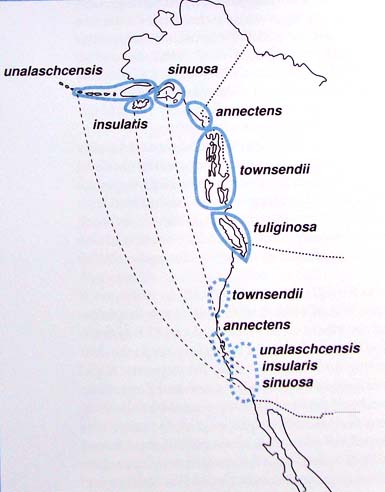 The Sooty Fox Sparrow group
is our standard migrant and winter visitor in Monterey County. It is
the one we need to learn first — in all its variations — before moving
on to identify members of other Fox Sparrow groups that are rare here
on the central California coast.
The Sooty Fox Sparrow group
is our standard migrant and winter visitor in Monterey County. It is
the one we need to learn first — in all its variations — before moving
on to identify members of other Fox Sparrow groups that are rare here
on the central California coast.  A review of MTY specimens reveals that our local wintering population is composed of birds assignable to races sinuosa and annectens, with annectens being slightly more common in collections [annectens predominates even more in Santa Cruz specimens]. These are subspecies from the central Alaska coast: sinuosa breeds from Kenai Peninsula to Prince William Sound while annectens breeds from Yakutat Sound to about Glacier Bay.
A review of MTY specimens reveals that our local wintering population is composed of birds assignable to races sinuosa and annectens, with annectens being slightly more common in collections [annectens predominates even more in Santa Cruz specimens]. These are subspecies from the central Alaska coast: sinuosa breeds from Kenai Peninsula to Prince William Sound while annectens breeds from Yakutat Sound to about Glacier Bay. 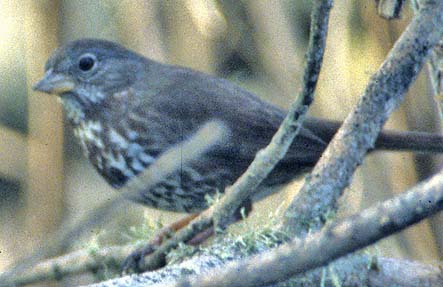


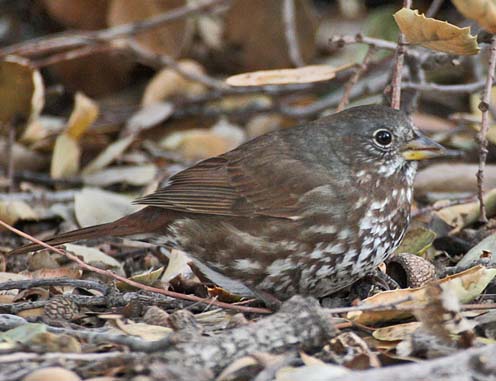 The southernmost breeding Sooty Fox Sparrows (townsendi, fuliginosa)
are exceedingly dark, and have very extensive spotting on the
underparts. The one above is rather heavily marked below; it could be annectens or maybe townsendi.
It was photographed at Palo Alto Baylands, Santa Clara Co., on 16 Oct
2007 (© Tom Grey). At this date it could be an arriving winterer
or a migrant still heading south. Its tail is decidedly duller than the
ruddy uppertail coverts.
The southernmost breeding Sooty Fox Sparrows (townsendi, fuliginosa)
are exceedingly dark, and have very extensive spotting on the
underparts. The one above is rather heavily marked below; it could be annectens or maybe townsendi.
It was photographed at Palo Alto Baylands, Santa Clara Co., on 16 Oct
2007 (© Tom Grey). At this date it could be an arriving winterer
or a migrant still heading south. Its tail is decidedly duller than the
ruddy uppertail coverts. 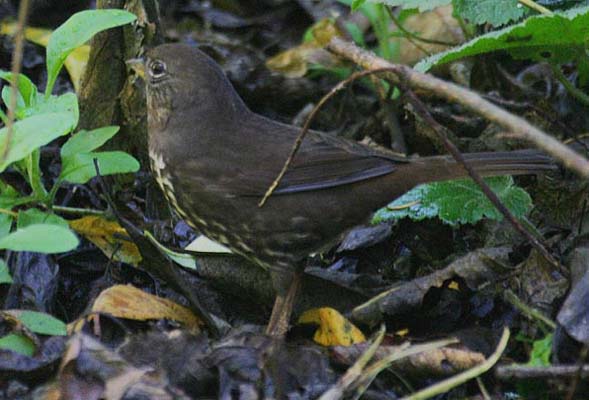 This
one (right), photographed 16 Oct 2005 in Mendocino Co. (© Glen
Tepke), is almost blackish brown, with exceedingly dark flanks and a
very dull, dark tail; I suspect it is fuliginosa. Mid-October is about the time such a bird would arrive to winter at this northwestern California locale. The fuliginosa
Fox Sparrows may be the dominant subspecies on the northwestern
California coast, and becoming scarcer as one reaches the central
coast.
This
one (right), photographed 16 Oct 2005 in Mendocino Co. (© Glen
Tepke), is almost blackish brown, with exceedingly dark flanks and a
very dull, dark tail; I suspect it is fuliginosa. Mid-October is about the time such a bird would arrive to winter at this northwestern California locale. The fuliginosa
Fox Sparrows may be the dominant subspecies on the northwestern
California coast, and becoming scarcer as one reaches the central
coast. 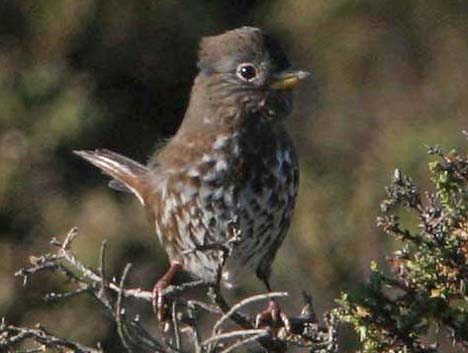 In Monterey County there are 3 specimens attributed to fuliginosa, and others attributed to townsendi
were collected in Santa Cruz County. Clearly some of these birds winter
here. This one (left), photographed at Zmudowski SB on 21 Jan 2007
(© D. Roberson), seems to me to be either townsendi or fuliginosa because it is very dark brown, heavily marked below, and has a dark tail. This one was wintering in coastal chaparral.
In Monterey County there are 3 specimens attributed to fuliginosa, and others attributed to townsendi
were collected in Santa Cruz County. Clearly some of these birds winter
here. This one (left), photographed at Zmudowski SB on 21 Jan 2007
(© D. Roberson), seems to me to be either townsendi or fuliginosa because it is very dark brown, heavily marked below, and has a dark tail. This one was wintering in coastal chaparral.